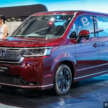The second-generation Hyundai Palisade was launched in Indonesia in June 2025, just a little over six months after its initial reveal in December 2024. The seven-seater is currently on display at the ongoing Gaikindo Indonesia International Auto Show (GIIAS), so here’s a live gallery of the brand’s flagship SUV.
Available in three variants there, the latest Palisade starts at 1.105 billion rupiah (about RM286k) for the base Signature 2WD. This is followed by the mid-range Calligraphy 2WD at 1.274 billion rupiah (RM330k) and the range-topping Calligraphy AWD at 1.359 billion rupiah (RM352k).
All variants get the same Smartstream G2.5T Hybrid powertrain, which features a 2.5 litre turbocharged inline-four petrol engine making 262 PS (258 hp or 193 kW) at 5,800 rpm and 353 Nm of torque from 1,800 to 4,500 rpm. This is augmented by an electric motor rated at 73 PS (72 hp or 54 kW) and 264 Nm, resulting in a total system output of 334 PS (329 hp or 246 kW) and 460 Nm.
It should be noted the previous-generation Palisade facelift launched in Indonesia in 2022 was a diesel-only affair that had a lower starting price. Malaysia got this model later in January 2023 with a choice of turbodiesel and naturally-aspirated petrol engines – the Palisade is currently absent from Hyundai Malaysia’s website.
The hybridised engine is paired exclusively with a six-speed automatic transmission, with drive going to either the front or all four wheels – the variant names are clear indicators. Selectable drive modes come as standard, with the sole AWD variant gaining an additional Multi Terrain Mode system.
In terms of equipment, the Signature 2WD comes with 20-inch wheels, LED projector headlamps, LED taillights, a panoramic curved display with dual 12.3-inch screens (infotainment and instrument cluster), leather seat upholstery, powered front seats with driver’s side memory function, dual-zone air-conditioning with rear vents and controls, a wireless charging pad, a hands-free powered tailgate, a Bose sound system and Bluelink telematics.
The seven seats are arranged in a 2-2-3 layout with captain seats in the second row and a 60:40 split-folding bench in the third row, all of which are manually operated. The third-row seats are two-way adjustable for recline only, while the two captain chairs can be folded down from the boot.
Meanwhile, the Calligraphy improves upon the base option by sporting larger 21-inch alloys and variant-specific styling package. The latter includes a six-sided grille that differs from the rectangular-shaped one on the Signature, while the new-profile front bumper better emphasises the SUV’s width and comes with chrome inserts. The side rocker panels, wheel arch garnish and tailgate back panel also have a different design and/or finish to them.
Other improvements over the Signature include Nappe leather upholstery, a heated steering wheel, a head-up display and an in-car fingerprint authentication system. Of more significance are the seat upgrades, with the driver getting the brand’s Ergo Motion seat with internal air pockets.
The front seats also offer more adjustability (18-way driver vs 12-way; 12-way front passenger vs eight-way), while the remaining seats are all power operated (six-way for the second row and four-way for the third row). As such, the first and second rows get a Premium Relaxation mode, while the second and third rows can be folded or unfolded using switches in the boot.
As for safety and driver assistance systems, the entire Palisade range comes standard with six airbags (front, side and curtain), ESC, ABS, hill start assist, trailer stability assist, multi-collision brake, high beam assist, forward collision-avoidance assist 2.0, driver attention monitoring, manual speed limit assist, active cruise control with stop and go, lane keep assist, lane following assist, blind spot collision avoidance asst, a surround view monitor, blind spot view monitor, safe exit assist and all-around parking sensors. The AWD variant gets an additional downhill brake control system.
In its second generation, the Palisade is larger than its facelifted predecessor by measuring 5,065 mm long (+70 mm), 1,980 mm wide (+5 mm), 1,805 mm tall (+55 mm) and with a wheelbase spanning 2,970 mm (+70 mm).
Buyers of the Signature will have Shimmering Silver Metallic, Creamy White Pearl, Ecotranic Gray Pearl and Abyss Black Pearl as available colour options. The Calligraphy variants get an additional Robust Emerald Peal hue. A four-year, 100,000-km warranty comes standard with each purchase along with a four-year, 60,000-km service package and eight-year, 160,000-km hybrid battery warranty.
GALLERY: 2025 Hyundai Palisade Calligraphy at the 2025 Gaikindo Indonesia International Auto Show
GALLERY: 2025 Hyundai Palisade Indonesian brochure









































































































































































































































































































































































































